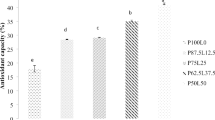Abstract
There are different herbal teas in the world, however always new and functional herbal teas are presented to consumer preference. The seeds of Rumex crispus L., also known as ‘kalmuk’ or ‘kalmek’ are infused by boiling water and filtrated and mixed boiled milk. Generally it is consumed in autumn and winter season. The consumption of this herbal tea could offer some beneficial influence as it contains antioxidant substances and phenolics which is associated with the health effects. In the present study, milk was incorporated with the Rumex crispus L. extract at different concentrations and some physicochemical, bioactive and sensory properties of samples were investigated by using multi-criteria decision making techniques. The technique for order preference by similarity to ideal solution (TOPSIS) approach and simple additive weighting (SAW) approach were used for the determination of the optimum sensory and bioactive characteristics of the products. The total phenolic content of the extract of R. crispus L. seeds was found as 31.82 ± 1.6 mg GAE/g. The highest IC50 value was observed in sample containing 70% milk and the lowest was observed in extract of R. crispus L. According to the results of SAW and TOPSIS methods, the samples coded as S5 and S6 were the best samples based on the sensory and bioactive properties.




Similar content being viewed by others
References
D. Desideri et al., Microchem. J. 98(1), 170–175 (2011)
P. Deetae et al., Food Chem. 133(3), 953–959 (2012)
J. Zhao et al., J. Chromatogr. 1313, 2–23 (2013)
S.I. Trevisanato, Y.I. Kim, Nutr. Rev. 58(1), 1–10 (2000)
D.L. McKay, J.B. Blumberg., J. Am. Coll. Nutr. 21(1), 1–13 (2002)
A. Kosińska, W. Andlauer, in Processing and Impact on Antioxidants in Beverages. Antioxidant Capacity of Tea. Effect of Processing and Storage, (Elsevier, Oxford, 2014). pp. 109–120
D. Huang, B. Ou, R.L. Prior, J. Agric. Food Chem. 53(6), 1841–1856 (2005)
B. Halliwell, Biochem. Pharmacol. 49(10), 1341–1348 (1995)
C. Kaur, H.C. Kapoor, Food Sci. Technol. 36(7), 703–725 (2001)
D.P. Arcari et al., J. Funct. Foods 3(3), 190–197 (2011). doi: 10.1016/j.jff.2011.04.001
H.-J. Suh et al., J. Photochem. Photobiol. B 102(2), 102–107 (2011)
J. Cullen, Rumex. Flora of Turkey and East Aegean Islands. ed. by Davis P.H., vol. 2 (Edinburgh University Press, Edinburgh, 1972)
T. Baytop, Istanbul Üniversitesi Yayınları. (Istanbul University, Istanbul, 1996), p. 444
I. Coruh et al., Pharm. Biol. 46(9), 634–638 (2008)
A. Yildirim, A. Mavi, A.A. Kara, J. Agric. Food Chem. 49(8), 4083–4089 (2001)
S. Pohekar, M. Ramachandran, Renew. Sust. Energy Rev. 8(4), 365–381 (2004)
T. Özcan, N. Çelebi, Ş. Esnaf, Expert Syst. Appl. 38(8), 9773–9779 (2011)
T.L. Saaty, The Analytic Hierarchy Process. (McGraw-Hill, New York, 1980)
H.P. Ren, W.Z. Liu, Adv. J Food Sci. Technol. 9(2), 87–91 (2015)
M. Dogan et al., Eur. Food Res. Technol. 242(6), 953–966 (2016)
V.E. Gurmeric et al., Food Bioprocess Tech. 6(10), 2844–2859 (2013)
G. Ozturk et al., Food Biosci. 7, 45–55 (2014)
AOAC, Official Methods of Analysis, (Association of Official Analytical Chemists, Arlington, 2005)
C. Li, W. Han, M.H. Wang, J. Appl. Biol. Chem. 53(1), 8–12 (2010)
H.M. Habib et al., Food Chem. 141(1), 148–152 (2013)
D.L. Olson, Math. Comput. Modellıng 40(7), 721–727 (2004)
D. Jato-Espino et al., Autom. Constr. 45, 151–162 (2014)
A. Afshari, M. Mojahed, R.M. Yusuff, J. Int. Innov. Man. Technol. 1(5), 511–515 (2010)
S. Nehir El, S. Karakaya, Int. J. Food Sci. Nutr. 55(1), 67–74 (2004)
M. Korir et al., Food Chem., 145, 145–153, (2014)
M.J. Arts et al., J. Agric. Food Chem. 50(5), 1184–1187 (2002)
V. Sharma, H.V. Kumar, L.J.M. Rao, Food Res. Int. 41(2), 124–129 (2008)
A.A. Elzaawely, T.D. Xuan, S. Tawata, Biol. Pharm. Bull. 28(12), 2225–2230 (2005)
Y. Zhuang, L. Chen, L. Sun, J. Cao, J. Funct. Foods 4(1), 331–338 (2012)
V. de Freitas, N. Mateus, Curr. Organ. Chem. 16(6), 724–746 (2012)
I. Lesschaeve, A.C. Noble, Am. J. Clin. Nutr. 81(1), 330S–335S (2005)
Acknowledgements
The authors would like to thank the Unit of Scientific Investigations and Project in Erciyes University for its financial support of this work (Project Number: FBY09-1092).
Author information
Authors and Affiliations
Corresponding author
Rights and permissions
About this article
Cite this article
Dogan, M., Aslan, D. & Ozgur, A. Bioactive and sensorial characteristics of the milk based herbal (Rumex crispus L.) tea: multi-criteria decision making approach. Food Measure 12, 535–544 (2018). https://doi.org/10.1007/s11694-017-9665-4
Received:
Accepted:
Published:
Issue Date:
DOI: https://doi.org/10.1007/s11694-017-9665-4




